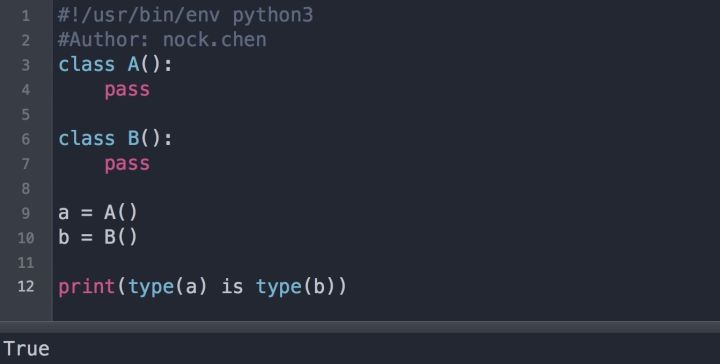


Python培训
400-996-5531
Python在定义变量的时候不用指明具体的的类型,解释器会在运行的时候会自动检查变量的类型,并根据需要进行隐式的类型转化,因为Python是动态语言,所以一般情况下是不推荐进行类型转化的。
比如进行”+”操作时,如果加号两边是数据就进行加法操作,如果两边是字符串就进行字符串连接操作,如果两边是列表就进行合并操作,甚至可以进行复数的运算。
解释器会在运行时根据两边的变量的类型调用不同的内部方法。当加号两边的变量类型不一样的时候,又不能进行类型转化,就会抛出TypeError的异常。
types模块从Python2到Python3的变化
在实际的开发中,为了提高代码的健壮性,我们还是需要进行类型检查的。而进行类型检查首先想到的就是用types(),比如使用types判断一个int类型:
Source Code:
#!/usr/bin/env python2.6
#Author: nock.chen
from types import *
mylist = ['nock', 100, '100', 'IT']
def delete(mylist, item):
if type(item) is IntType:
mylist.remove(item)
delete(mylist, 100)
print(mylist)
Result:
['nock', '100', 'IT']
我们在types模块中可以找到一些常用的类型,在2.6.9中显示的结果:
types.BooleanType # bool类型
types.BufferType # buffer类型
types.BuiltinFunctionType # 内建函数,比如len()
types.BuiltinMethodType # 内建方法,指的是类中的方法
types.ClassType # 类类型
types.CodeType # 代码块类型
types.ComplexType # 复数类型
types.DictProxyType # 字典代理类型
types.DictType # 字典类型
types.DictionaryType # 字典备用的类型
types.EllipsisType # Ellipsis类型
types.FileType # 文件类型
types.FloatType # 浮点类型
types.FrameType # 框架对象的类型
types.FunctionType # 函数类型
types.GeneratorType # 通过调用生成器函数生成的generator-iterator对象类型
types.GetSetDescriptorType # 用PyGetSetDef(如FrameType)在扩展模块中定义的对象的类型
types.InstanceType # 实例类型
types.IntType # int类型
types.LambdaType # lambda类型
types.ListType # 列表类型
types.LongType # long类型
types.MemberDescriptorType # 在扩展模块中定义的对象类型,包括PyMemberDef,如datetime.timedelta.days
types.MethodType # 方法类型
types.ModuleType # module类型
types.NoneType # None类型
types.NotImplementedType # NotImplemented的类型
types.ObjectType # object类型
types.SliceType # slice()返回的对象类型
types.StringType # 字符串类型
types.StringTypes # 一个包含StringType和UnicodeType的序列,用于方便对任何字符串对象进行检查。
types.TracebackType # 在sys.exc_traceback中发现的traceback对象的类型。
types.TupleType # 元组类型
types.TypeType # 类型本身
types.UnboundMethodType # 另一个名字for MethodType
types.UnicodeType # Unicode字符字符串的类型(例如,u ' spam)
types.XRangeType # xrange()返回的范围对象的类型
官网介绍:#/2/library/types.html
到了Python3版本,types模块方法已经明显减少了很多,具体如下:
types.BuiltinFunctionType
types.BuiltinMethodType # 内置函数的类型,如len()或sys.exit(),以及内置类的方法。(这里,“内置”的意思是“用C写”。)
types.CodeType # 通过compile()返回的代码对象类型。
types.DynamicClassAttribute
types.FrameType # 框架对象的类型,如在tb中发现的。tb_frame如果tb是一个traceback对象。
types.FunctionType
types.GeneratorType # 由生成器函数创建的generator - iterator对象类型。
types.GetSetDescriptorType # 用PyGetSetDef(如FrameType)在扩展模块中定义的对象的类型。
types.LambdaType # 由lambda表达式创建的用户定义函数和函数的类型。
types.MappingProxyType
types.MemberDescriptorType
types.MethodType # 用户定义类实例的方法类型。
types.ModuleType
types.SimpleNamespace
types.TracebackType # traceback对象的类型,如sys.exc_info()
types.new_class
types.prepare_class
官网介绍:#/3/library/types.html#module-types
不推荐使用type检查类型
从上面的Python2到Python3的版本升级过程中,types模块方法有所减少。如果使用type方法也会存在如下问题:

如上所示说明i和n的类型是不一样的,而实际上UserInt是继承int的,所以这个判断是存在问题的,当我们对Python内建类型进行扩展的时候,type返回的结果就不够准确了。我们再看一个例子:

这个时候我们就需要使用内置函数isinstance来进行类型检查,示例如下:
isinstance(object, class_or_type_or_tuple)
object表示对象,classinfo可以是直接或间接类名、基本类型或者有它们组成的元组。
nock:ucode nock$ python3
Python 3.5.1 (default, Dec 26 2015, 18:08:53)
[GCC 4.2.1 Compatible Apple LLVM 7.0.2 (clang-700.1.81)] on darwin
Type "help", "copyright", "credits" or "license" for more information.
>>> isinstance(2, float)
False
>>> isinstance(2, int)
True
>>> isinstance((2, 3), list)
False
>>> isinstance((2, 3), tuple)
True
>>> isinstance({'name': 'nock'}, tuple)
False
>>> isinstance({'name': 'nock'}, dict)
True
>>> isinstance([1, 100, 101], (str, list, tuple))
True
>>> isinstance(2 ** 31, dict)
False
>>> isinstance(2 ** 31, long)
Traceback (most recent call last):
File "<stdin>", line 1, in <module>
NameError: name 'long' is not defined
>>> isinstance(2 ** 31, int)
True
Python2有为非浮点数准备的int和long类型。int类型的大值不能超过sys.maxint,而且这个大值是平台相关的。可以通过在数字的末尾附上一个L来定义长整型,显然,它比int类型表示的数字范围更大。在Python3里,只有一种整数类型int,大多数情况下,它很像Python2里的长整型。由于已经不存在两种类型的整数,所以就没有必要使用特殊的语法去区别他们, 进一步阅读:PEP 237。
后在Python中类型的判断你好的方法是利用内置函数isinstance完成是佳体验。
填写下面表单即可预约申请免费试听! 怕学不会?助教全程陪读,随时解惑!担心就业?一地学习,可全国推荐就业!
Copyright © Tedu.cn All Rights Reserved 京ICP备08000853号-56  京公网安备 11010802029508号 达内时代科技集团有限公司 版权所有
京公网安备 11010802029508号 达内时代科技集团有限公司 版权所有